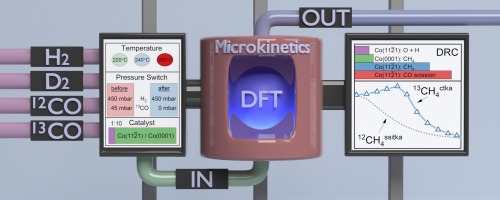Catalysis Today ( IF 5.3 ) Pub Date : 2019-03-04 , DOI: 10.1016/j.cattod.2019.03.002 Bart Zijlstra , Robin J.P. Broos , Wei Chen , Ivo A.W. Filot , Emiel J.M. Hensen

|
Computational efforts towards a fundamental understanding of the underlying mechanistic pathways in synthesis gas conversion processes such as Fischer-Tropsch synthesis are exemplary for the developments in heterogeneous catalysis. Advances in transient kinetic analysis methods contribute to unraveling complex reaction pathways over nanoparticle surfaces. Tracing the activity and selectivity of Fischer-Tropsch catalysts to the individual events occurring at the active site remains difficult with experimental techniques. Here we provide simulations of transient kinetics at the scale of the active site by making use of the reaction energetics for CO hydrogenation to methane on stepped and terrace cobalt surfaces that are suitable models for cobalt FT nanoparticle catalysts. We investigate the hydrogen-deuterium kinetic isotope effect and simulate common steady-state and chemical isotopic transients. Comparison to experimental literature leads to important mechanistic insights. Direct CO dissociation is the main pathway for breaking the CO bond and it occurs exclusively on step-edge sites. While the experimentally observed hydrogen-deuterium kinetic isotopic effect is often used as evidence for H-assisted CO dissociation, we show that hydrogenation of C and O as partly rate-controlling steps provides an alternative explanation. The simulations of the chemical transients provide significant insight into the importance of the changing surface coverages that strongly affect the reaction rate. The reversibility of CO dissociation on cobalt step-edges is evident from simulations of 12C16O/13C18O scrambling being in good agreement with experimental data.
中文翻译:

基于第一原理的钴催化剂上CO加氢瞬态动力学的微观动力学模型
对于非均相催化技术发展的例证,为基本理解诸如费-托合成等合成气转化过程中的基本机理途径所做的计算努力是示例性的。瞬态动力学分析方法的进展有助于揭示纳米颗粒表面上的复杂反应途径。用实验技术来追踪费-托催化剂对活性位点上发生的个别事件的活性和选择性仍然是困难的。在这里,我们通过利用阶跃和平台钴表面上适合于钴FT纳米粒子催化剂模型的CO加氢成甲烷的反应能量学,在活性部位范围内提供了瞬态动力学的模拟。我们研究氢氘动力学同位素效应,并模拟常见的稳态和化学同位素瞬变。与实验文献的比较产生了重要的机械见解。直接CO分解是破坏C的主要途径O键,它仅在台阶边缘的位置上发生。虽然实验观察到的氢-氘动力学同位素效应通常用作H辅助CO分解的证据,但我们表明C和O的氢化作为部分速率控制步骤提供了另一种解释。化学瞬态的仿真为深刻影响反应速率的不断变化的表面覆盖率的重要性提供了重要的见识。通过对12 C 16 O / 13 C 18 O加扰的模拟与实验数据非常吻合,可以看出钴台阶边缘上的CO分解具有可逆性。



























 京公网安备 11010802027423号
京公网安备 11010802027423号